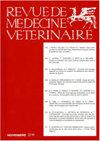Efecto de la temperatura ambiente en la temperatura superficial de zonas negras y blancas del pelaje de un hato de vacas holstein en el departamento de Antioquia, Colombia
Q2 Veterinary
引用次数: 0
Abstract
espanolEl articulo reporta la evaluacion del efecto de la temperatura ambiente, la humedad relativa, la radiacion solar y la velocidad del cuerpo bajo el indice THSW en la temperatura superficial de areas blancas y negras del pelaje de vacas holstein. Se utilizo informacion de 5 vacas holstein en produccion de la finca El Recreo, ubicada en el municipio de Abejorral, Colombia. Se les tomo la temperatura superficial cada 2 h durante 15 dias en 10 sitios diferentes: linea dorsal anterior, media y posterior, flanco derecho e izquierdo, pecho, cuello derecho e izquierdo, vulva y glandula mamaria, con termometro infrarrojo. Para evaluar el efecto de la temperatura ambiente en la corporal se utilizo un indice que involucra la temperatura, la humedad, la radiacion y la velocidad del viento (THSW) y para el analisis estadistico se utilizo un modelo mixto aditivo generalizado suavizado. El THSW encontrado fue de 10 y 27 °C. Las areas muestreadas tuvieron una diferencia en la temperatura; las de color negro fueron las de mayor temperatura superficial. Oscilaron entre 32,5 y 35,8 °C para zonas blancas, y entre 34,5 y 40,5 °C para zonas negras. Los mayores valores de temperatura superficial para ambas zonas en todos los puntos se presentaron a mayores valores de THSW. Se concluye que el indice THSW tiene efecto diferenciado en la temperatura superficial corporal de acuerdo con el color del pelaje; los puntos negros fueron los que presentaron mayores temperaturas. EnglishThe article evaluates the effect of ambient temperature, relative humidity, solar radiation, and wind speed according to the THSW index on the surface temperature of the white and black areas of the coat of Holstein cows. The study used information of five Holstein dairy cows from the El Recreo farm, located in the municipality of Abejorral, Colombia. Surface temperature was measured with an infrared thermometer every 2 h during 15 days in 10 different sites: anterior, middle, and posterior dorsal line, right and left flank, chest, right and left neck, vulva, and mammary gland. To evaluate the effect of ambient temperature on body temperature, an index that involves temperature, humidity, solar radiation, and wind speed (THSW) was used, and for statistical analysis, a mixed generalized additive model. THSW was 10 and 27 °C. The sampled areas had a difference in temperature; being the black spots that had higher surface temperature. Temperature oscillated between 32.5 and 35.8 °C for white areas, and between 34.5 and 40.5 °C for black areas. Higher surface temperature values for both zones at all points had higher THSW values. It is concluded that the THSW index has a differentiated effect on body surface temperature according to the color of the coat, the black spots having higher temperatures. portuguesO artigo reporta a avaliacao do efeito da temperatura ambiente, a umidade relativa, a radiacao solar e a velocidade do corpo sob o indice THSW na temperatura superficial de areas brancas e negras da pelagem de vacas Holstein. Utilizou-se informacao de 5 vacas Holstein em producao do sitio El Recreo, situada no municipio de Abejorral, Colomba. Tomou-se a temperatura superficial destes a cada 2 horas durante 15 dias em 10 lugares diferentes: linha dorsal anterior, media e posterior, flanco direito e esquerdo, peito, pescoco lado direito e esquerdo, vulva e glândula mamaria, com termometro infravermelho. Para avaliar o efeito da temperatura ambiente na corporal utilizou-se um indice que envolve a temperatura, a umidade, a radiacao e a velocidade do vento (THSW) e para a analise estatistico utilizou-se um modelo misto aditivo generalizado suavizado. O THSW encontrado foi de 10 e 27 °C. As areas amostradas tiveram uma diferenca na temperatura; as de cor negra foram as de maior temperatura superficial. Oscilaram entre 32,5 e 35,8 °C para zonas brancas, e entre 34,5 e 40,5 °C para zonas negras. Os maiores valores de temperatura superficial para ambas zonas em todos os pontos, se apresentaram a maiores valores de THSW. Conclui-se que o indice THSW tem efeito diferenciado na temperatura superficial corporal de acordo com a cor da pelagem; os pontos negros foram os que apresentaram maiores temperaturas.环境温度对哥伦比亚安蒂奥基亚省一群荷斯坦奶牛皮毛黑白区域表面温度的影响
本文报道了环境温度、相对湿度、太阳辐射和THSW指数下的体速对荷斯坦奶牛黑白皮毛表面温度的影响。本研究的目的是评估在哥伦比亚阿比约拉尔市El Recreo农场生产的5头荷斯坦奶牛的信息。在15天内,每2小时在10个不同部位(前、中、后背线、左右两侧、胸部、左右颈部、外阴和乳腺)测量表面温度。为了评估环境温度对人体的影响,我们使用了包括温度、湿度、辐射和风速(THSW)在内的指标,并使用平滑的广义加性混合模型进行统计分析。THSW分别为10°C和27°C。取样区域的温度有差异;在本研究中,我们分析了三种不同颜色的样品。白色区域的温度范围为32.5°C至35.8°C,黑色区域的温度范围为34.5°C至40.5°C。在THSW值较高的情况下,两个区域的地表温度值均较高。结果表明,THSW指数对被毛颜色对体表温度有不同的影响;在本研究中,我们分析了不同温度下的黑点。这篇文章评估了环境温度、相对湿度、太阳辐射和风速的影响,根据THSW指数对荷斯坦奶牛皮肤白区和黑区表面温度的影响。该研究使用了来自哥伦比亚Abejorral市El Recreo农场的5头荷斯坦奶牛的信息。在15天内,每2小时用红外温度计测量10个不同部位的表面温度:前、中、后背线、左右两侧、胸部、左右颈部、外阴和乳房龟头。为了评估环境温度对人体温度的影响,采用了包括温度、湿度、太阳辐射和风速(THSW)在内的指标,并采用了混合广义加性模型进行统计分析。= =地理= =根据美国人口普查局的数据,该县总面积为,其中土地和(1.0%)水。取样区域的温度有差异;= =地理= =根据美国人口普查局的数据,该县的总面积为,其中土地和(1.)水。= =地理= =根据美国人口普查局的数据,该镇总面积为,其中土地和(1.0%)水。= =地理= =根据美国人口普查局的数据,该县总面积为,其中土地和(1.1%)水。It is concluded that the THSW index has a获益effect on body surface temperature to the color of the vanniiere the black且高等temperatures公益宣传。本文报道了环境温度、相对湿度、太阳辐射和体速在THSW指数下对荷斯坦奶牛黑白皮毛表面温度的影响。我们使用了5头荷斯坦奶牛在El Recreo农场生产的信息,该农场位于科伦巴的Abejorral市。在15天内,每2小时测量10个不同部位的表面温度:前、中、后背线、左右两侧、胸部、左右颈部、外阴和乳腺,用红外温度计测量。为了评估环境温度对人体的影响,我们使用了包括温度、湿度、辐射和风速(THSW)在内的指标,并使用平滑的广义加性混合模型进行统计分析。THSW分别为10°C和27°C。取样区域的温度不同;黑色的表面温度最高。白色区域的温度在32.5 - 35.8°C之间,黑色区域的温度在34.5 - 40.5°C之间。两个区域的表面温度值均较高,THSW值较高。结果表明,THSW指数对体表温度的影响因被毛颜色的不同而不同;黑点是温度最高的。
本文章由计算机程序翻译,如有差异,请以英文原文为准。
求助全文
约1分钟内获得全文
求助全文
来源期刊

Revue De Medecine Veterinaire
农林科学-兽医学
CiteScore
1.30
自引率
0.00%
发文量
0
审稿时长
18-36 weeks
期刊介绍:
The Revue de Médecine Vétérinaire publishes four kinds of text:
1) Scientific reviews on subjects related to veterinary and comparative medicine. Suggested length: 10 to 30 typed pages.
2) Original reports on fundamental or applied research. Suggested length: 10 to 15 typed pages.
3) Continuous education articles, that should be easily understandable by non-specialists. Suggested length: 10 to 15 typed pages.
4) Clinical reports. Suggested length: 5 to 15 typed pages.
The publication can be done in French language or English language.
For an article written in English by not english native speakers authors, the manuscript must be subjected by attesting that it was read again by an anglophone scientist or a scientific translator.
The authors must certify that the manuscript was not published or subjected for publication to another review.
The manuscript must be accompanied by a sheet signed by all the joint authors indicating their agreement for the tender of the manuscript.
The publication is free but a financial participation could be required for the photographs color. An estimate will be sent to collect the agreement of the authors.
 求助内容:
求助内容: 应助结果提醒方式:
应助结果提醒方式:


